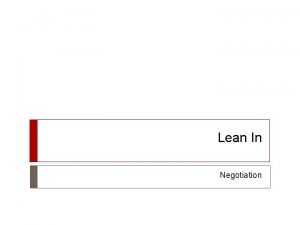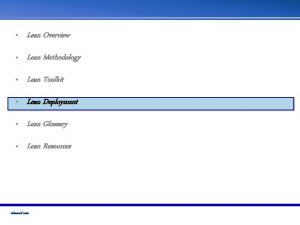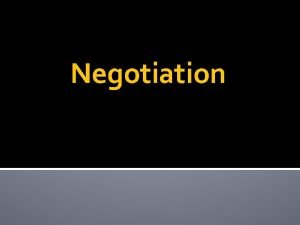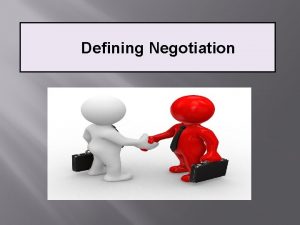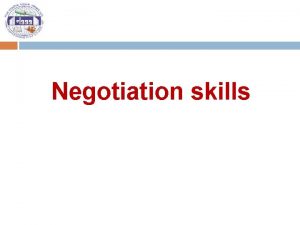Lean In Negotiation Agenda for today 7 30









- Slides: 9

Lean In Negotiation

Agenda for today 7. 30 – 8: 00 - Lean In and meet � 8. 00 - 8. 05 - Lean in overall objective, Educational meeting and Negotiation � 8. 10 - 8. 30 - VIDEO � 8: 30 - 8: 50 – Discuss key topics � 8. 50 - 9. 20 - Group delegate to share their Negotiation story with the group � 9: 20 – 9: 30 – Wrap up, feedback, info on next meeting's topic � 9: 30 - Onwards (Optional Social at local Pub) �

Links for today � Lean in � http: //leanin. org/book/ � Negotiation � http: //leanin. org/education/negotiation/

Lean in The book Lean In is focused on encouraging women to pursue their ambitions, and changing the conversation from what we can’t do to what we can do. Lean. In. Org is the next chapter. � We are committed to offering women the ongoing inspiration and support to help them achieve their goals. If we talk openly about the challenges women face and work together, we can change the trajectory of women and create a better world for everyone. Lean In supports women in 3 important ways: Community � We want all women to have the confidence and know-how to achieve their goals. This starts with an active and supportive community. Each day we’ll encourage an open exchange of ideas and information. We will also share Lean In Stories—short narratives of moments in life when we choose to “lean in” or “lean back” intended to inspire, teach and connect us. Education � We offer a growing library of free online lectures on topics including leadership and communication. Produced in partnership with the Clayman Institute for Gender Studies at Stanford University and other well-known experts, these lectures offer women practical skills they can apply in their daily lives. Circles � Lean In Circles are small groups that meet monthly to encourage and support each other in an atmosphere of confidentiality and trust. We provide the materials and support to run a successful Circle, including online spaces that make it easy for members to stay up-to-date and connected. Circles are powered by Mightybell, the first network of private groups. �

Is there an alternative solution that can benefit both you and me? � The goal is not to get a deal. The goal is to a good deal. � Getting a good deal is the desired outcome of a negotiation. Agreement is not. Every bad deal is a deal to which you have agreed. To define a good deal, understand three things upfront: � What are your alternatives? What do you have “in hand” in case a new agreement is not reached? The person with superior alternatives does better. � What is your reservation? The bottom line — below this, you are better o! walking away. Above this, you are better off � What is your aspiration for the deal? What is your realistic view of the best possible outcome? Aim high, but also support your goals with arguments about why your “Ask” is reasonable.

Four steps to achieving a successful negotiation 1. Assess. Do the benefits of engaging in this negotiation outweigh the costs? Can you have influence in this situation? What is the price you are willing to pay to avoid negotiating? 2. Prepare. What are your interests in this negotiation? What are the interests of your counterpart? 3. Ask. Engage with your counterpart. You have unique information your counterpart needs. Your conversations with your counterparts give you the opportunity to share this information as well as listen to their perspective. 4. Package. Make proposals that package together issues and solutions. Start with the results you can deliver to your counterparts, your team, or your organization. Do not negotiate issue by issue. Use “if/then” statements as a tool to present your “Ask. ”

Three questions to prepare women to enter a negotiation 1. Why are you asking? How will my solution or desired outcome benefit my counterpart, my team, and/or my organization? Start with the benefits to your counterpart, team, or organization. 2. How are you asking? Are you bundling your requests with benefits to your counterparts, team or organization? Package individual requests together into a proposal using “if/then statements. ” Stay away from single-issue negotiations. 3. For whom are you asking? If you are able to achieve these desired outcomes, who else will benefit? How does your proposal represent the interests of your family, your group, or your cause? When you are asking, think about how your proposal benefits them.

Personal inventory � Think of your a recent negotiation. What were the benefits of undertaking this negotiation? What were the risks of undertaking this negotiation? � What was important to your counterpart? What was important to you? In what areas did you and your counterpart share the same interests? � W hat were the different issues and options you packaged in your proposal? How did the proposal benefit your counterparts? What was the outcome?

Exercise � Break into GROUPS OF 5. Share with your partner an unresolved issue that you would like to resolve with an “Ask. ” � � � What is the situation? Who is your counterpart? What do you know about your counterpart? What is important to them? What results are they responsible for generating? What specific results or value do you bring to your counterpart in delivering their results? What is your realistic view of the best possible outcome? Assess. Do the benefits of engaging in this negotiation outweigh the costs? Can you have influence in this situation? � Prepare. What are your interests in this negotiation? What are the interests of your counterpart? What are your alternatives to this negotiation? � Ask. When you engage with your counterpart, what is the unique information that you have to share? What is the unique information you would like to get? Practice your negotiation with your partner. � Package. What are the different issues you can package
